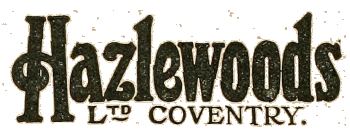


The 8 h.p. Hazlewood sidecar outfit is altered in several details, and fitted with 3in. tyres
The Hazlewood Co. adopt an 8 h.p. J.A.P. Engine for Their New Passenger Outfit.
As was to be expected after a successful year's trading, all the well-known features of Hazlewood machines have been retained for 1921. Nevertheless, such considerable additions and modifications have been made that the latest models present quite a new appearance. Perhaps the most striking machine is the 8 h.p. J.A.P.-engined passenger outfit, on which the changes that immediately catch the eye are the saddle tank covering a straight top tube frame, the new spring seat-pillar, compound action Druid type forks, and 28x3in. tyres. A choice of either chain and belt or all-chain drive is provided, and in the latter case a spring shock absorber is fitted to the rear hub. Of course, the Hazlewood three-speed countershaft gear and cork insert clutch is retained, also the large flat brake drum on the rear wheel.
Detail Improvements.
The silencer is held in position by the two bolts which support the large footboard castings. Excellent mudguards are fitted, and the magneto is provided with a special metal shield. Detail improvements include steel castings for all the main frame lugs, and a very smart finish in black and grey. The sidecar provided for this imposing machine is a new production by Messrs. Mead and Deakin, and is finished in grey to match the machine. As in previous years, the two front attachment lugs incorporated with the head are reinforced by a special strengthening plate, which also simplifies the process of attachment.
A smaller model, fitted with the new 6 h.p. J. A. P., conforms more nearly to previous Hazlewood models, since the curved top tube is retained. In this case 650x55 mm. tyres are fitted, and a lighter Canoelet sidecar is attached. With these exceptions the smaller machine resembles the 8 h.p. type in practically every detail.
For the solo enthusiast, the 6 h.p. Hazlewood is specially modified, and in this instance is provided with footrests instead of footboards, a hand-controlled clutch, and a brake pedal set in a particularly convenient position.
Every make of machine worthy of its name has its own peculiarity, and the distinguishing feature of all recent Hazlewood models is a certain sturdiness of construction which gives the impression of great strength without excessive weight. The machine is most practical in every respect, though a few will be apt to criticise the retention of foot clutch control for the standard models. This, however, can be altered to suit the needs of those who prefer hand control, and there are still many who prefer a clutch pedal on passenger machines.
The Motor Cycle November 25th, 1920. Page 656